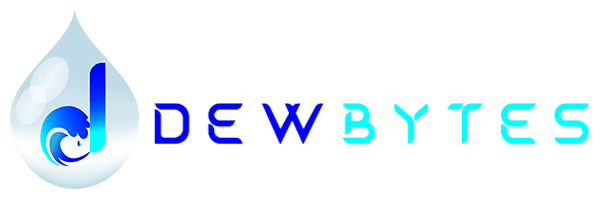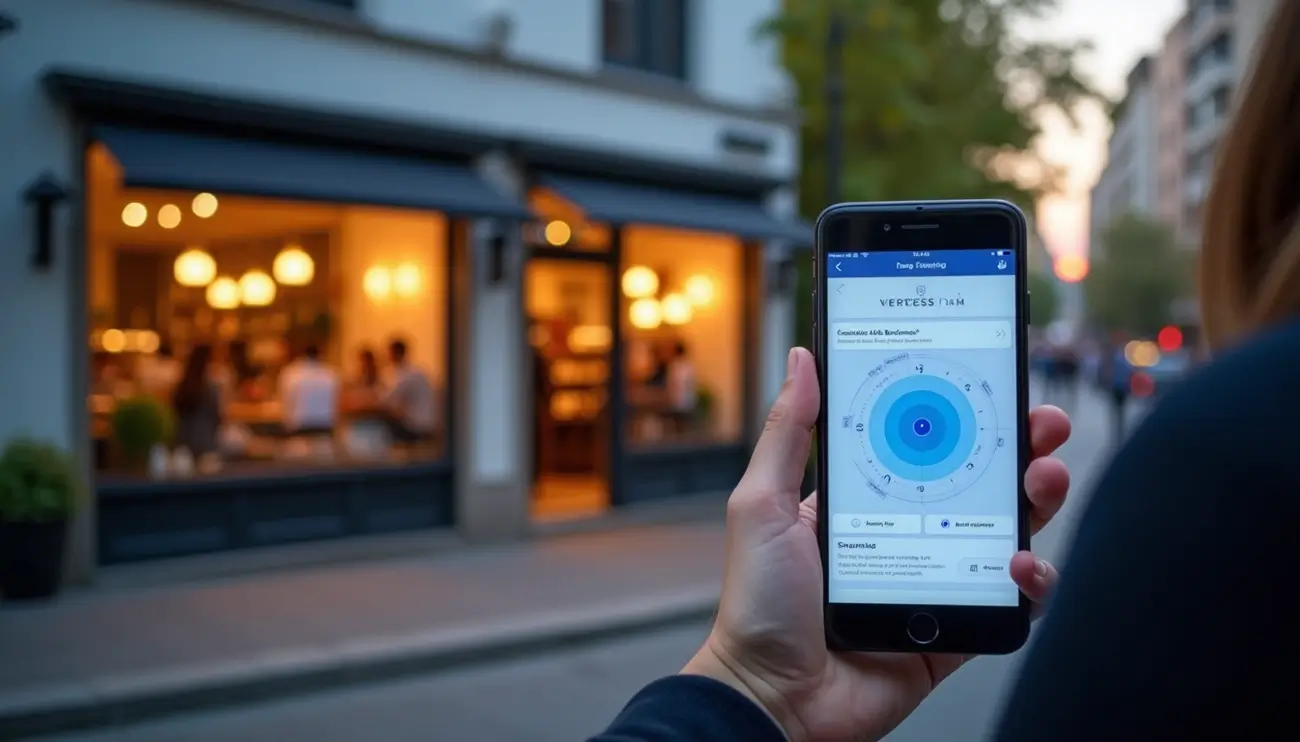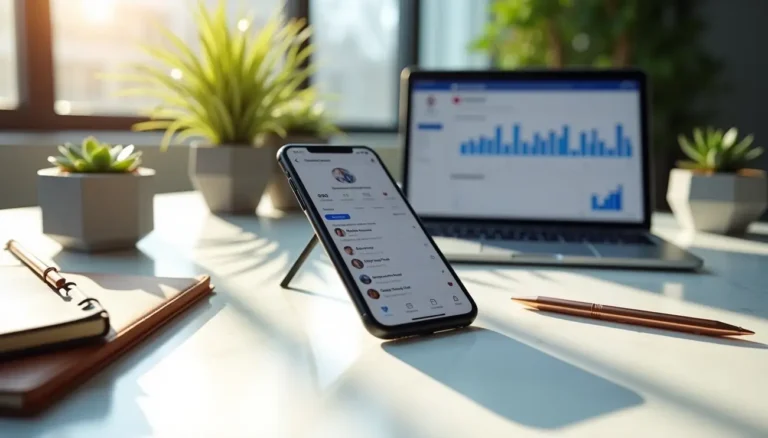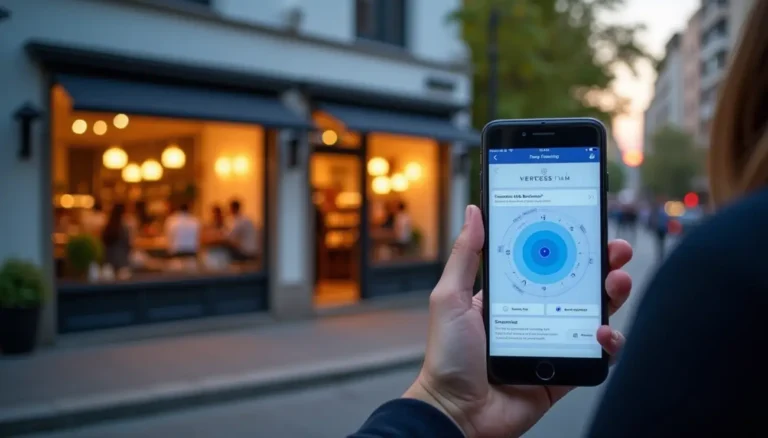Facebook ads targeting strategy reaches over 2.9 billion active users each month – which looks a mind-blowing number. Your local business can connect with potential customers through this platform, especially since 81% of adults have Facebook accounts.
The platform’s ads excel at precise targeting. You can target users based on their demographics, interests, and behaviors, which makes them perfect for local businesses. These ads give you more targeting options and reach than print advertising ever could. Our research shows that local businesses spend less on Facebook ads compared to traditional advertising channels like print or TV.
Setting up effective Facebook ads strategy can be tricky if you don’t know what you’re doing. This piece will show you how to create campaigns that work with a ₹500/day budget. You’ll learn to use targeting options, create the right audience segments, and watch your campaign performance to get the best return on investment.
Want to change how you connect with local customers? Let’s take a closer look.
Check Page Contents
ToggleUnderstanding Facebook Ads Targeting for Local Businesses
Facebook ad targeting works differently for local businesses compared to national campaigns. Your ₹500 daily ad spend can bring amazing results if you know these differences and use the platform’s targeting tools the right way.
Why local targeting is different from national campaigns
The biggest difference between local and national campaigns comes down to audience size. Local businesses aim at much smaller geographic areas with fewer people than national advertisers. National campaigns might target whole countries with 50+ million users, while local targeting focuses on just one city with about 100,000-200,000 people.
This smaller audience means local businesses need a different approach to targeting. Local campaigns need broader targeting within a specific area instead of narrowing down huge audiences with specific filters. Local businesses also need to think about how far customers will travel. A gym might target people within a 5-mile radius, but specialized services like interior design can cast their net wider.
How Facebook Ads targeting options work
Facebook decides who sees your ads by looking at several signals. The platform looks at:
- Details users share (age, gender, education)
- Pages users like and ads they click
- What users do across Meta platforms
- Their mobile devices and connections
This information creates a detailed profile that helps target ads precisely. Location targeting helps local businesses reach people in specific areas, though Meta mentions they can’t guarantee perfect accuracy.
Facebook uses all this data to pick who should see your ads. Your advertising money goes further because your ads reach people who are more likely to be interested.
Overview of Facebook Ads targeting audience types
Facebook gives local businesses three main ways to target audiences:
Detailed Targeting helps you reach people based on who they are, what they like, and how they behave. A local coffee shop could target people who follow big coffee brands on Facebook.
Custom Audiences let you show ads to people whose contact info you already have (with their permission). This feature helps you stay connected with existing customers or leads.
Lookalike Audiences find new customers by matching patterns from your successful campaigns. Facebook finds users similar to your best customers, usually 1-10% of a country’s population. Local businesses should stick to 1% for better results.
Facebook’s precise targeting beats traditional advertising. Your local business message reaches exactly the right people at the right time, making every dollar of your daily budget count.
Setting Up Your Campaign for ₹500/Day Results
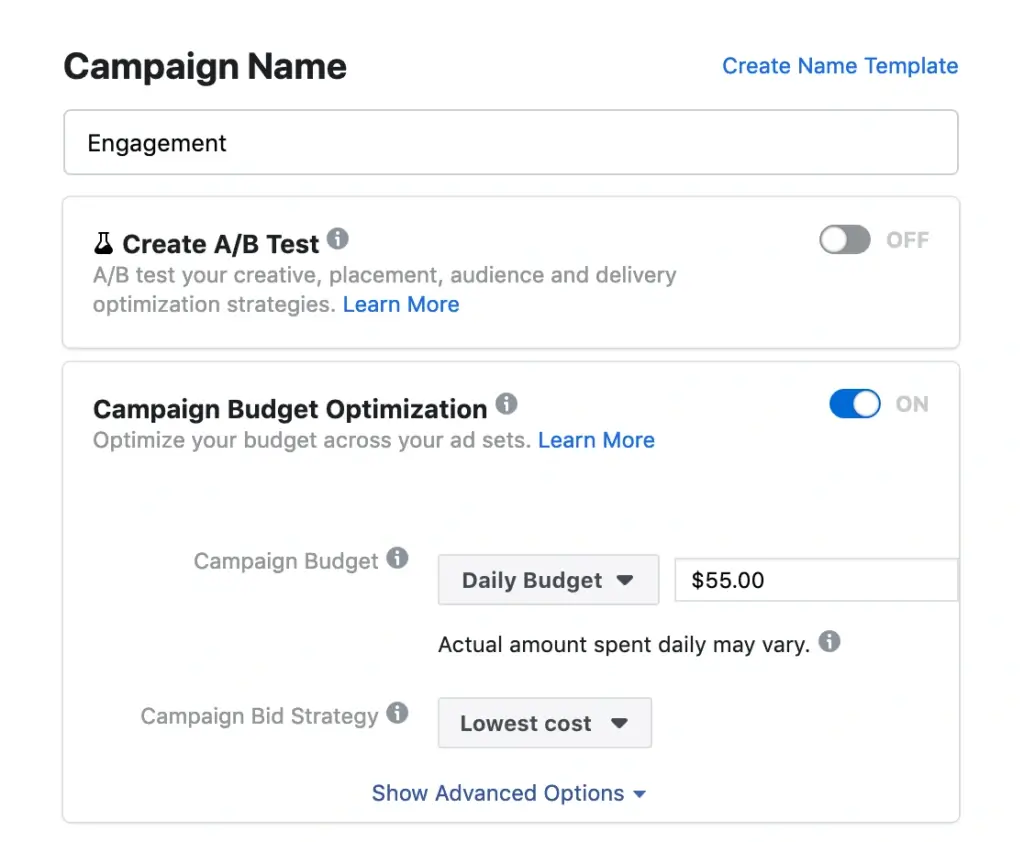
Image Source: Flyte New Media
Your ₹500 daily budget can generate consistent results when you set up the perfect Facebook ad campaign. The right configurations will help your local business achieve impressive returns on this investment.
Some of our Live Facebook Ad campaign results
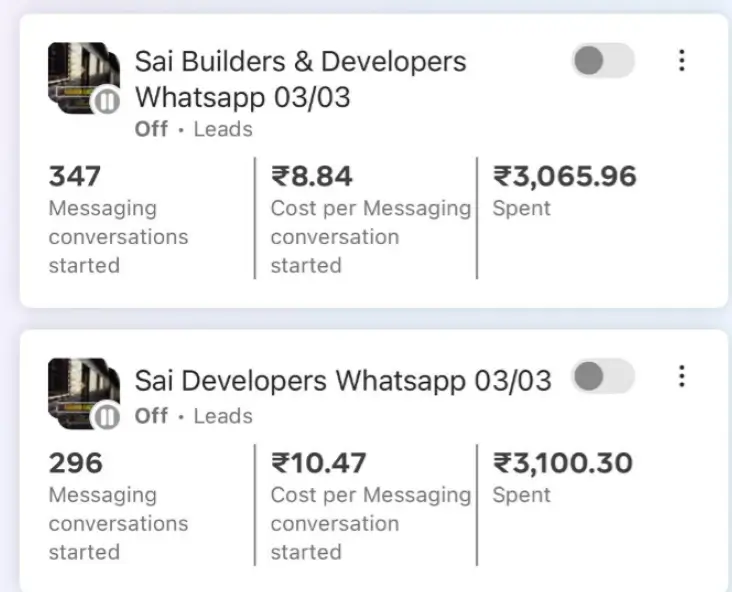
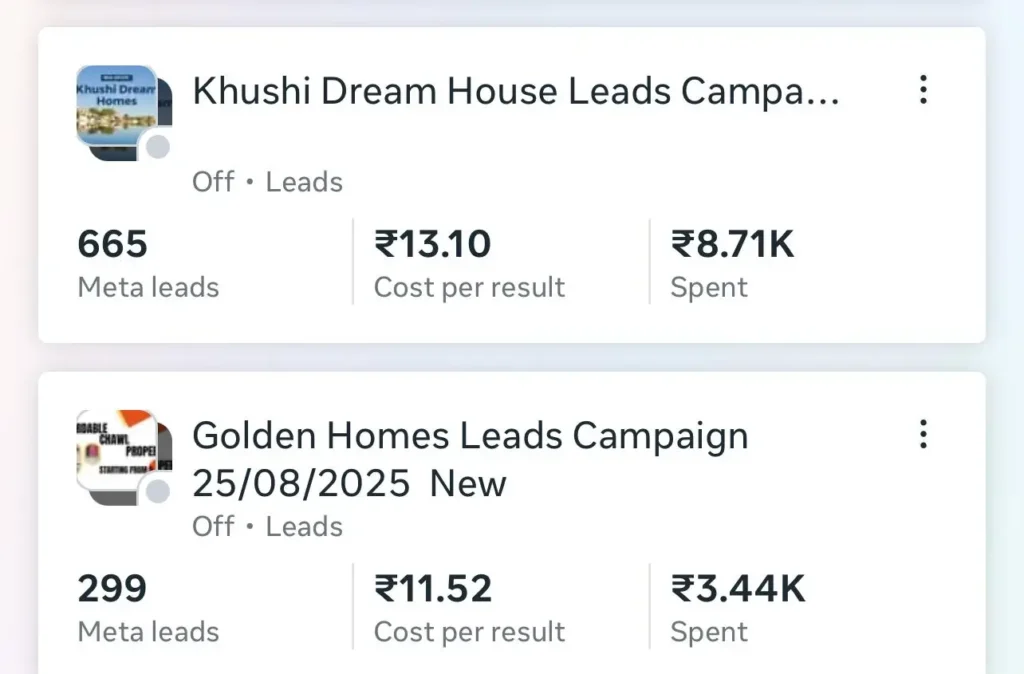
Choosing the right campaign objective
Facebook’s algorithm needs to know your goals. Meta provides six main objectives:
- Sales – For driving purchases or bookings
- Leads – For collecting contact information
- Engagement – For increasing interaction with your content
- App promotion – For driving app installs or engagement
- Traffic – For sending people to your website
- Awareness – For maximizing reach among your target audience
Meta delivers your ads based on your chosen objective. Local businesses spending ₹500 daily see the strongest results with the Leads objective. This works best to collect contact information from potential customers nearby. The Engagement objective might work better if you promote a local event or special offer.
Local business owners often start with Sales objectives. This strategy limits growth potential. Some businesses have seen their Facebook accounts grow exponentially by focusing on engagement.
Setting daily vs. lifetime budget
Your campaign’s performance depends on choosing between daily and lifetime budgets. This decision affects your spending patterns.
A daily budget means Facebook spends your allocated amount each day. This creates predictable spending that makes financial planning easier. Steady exposure works well for ongoing campaigns. Facebook caps weekly spending at $700 for a ₹500 daily budget.
A lifetime budget lets Facebook spend more money when performance peaks. This flexibility often brings better results but makes daily spending unpredictable.
Most local businesses do well with a daily budget of ₹500-₹1000. This amount helps Facebook’s algorithm optimize while keeping costs reasonable. Successful local businesses spend ₹50,000-₹1,00,000 monthly for predictable results.
Using Facebook Ads Manager effectively
The “Boost Post” button seems simple but lacks detailed controls. Ads Manager gives you full control over targeting, placements, and objectives.
Your ₹500 daily budget works best when you:
- Monitor campaigns through Ads Manager
- Wait a week before making big changes
- Adjust budgets by 20% or less to keep the algorithm stable
- Use collected data to improve targeting and creative elements
Facebook needs about 50 optimization events to find your best audience. Costs might rise during this learning phase while performance varies.
Dewbytes can help once your campaigns run smoothly. Their Facebook Ad services create successful lead generation campaigns for your brand. Their expertise can boost your results through advanced targeting and optimization strategies.
Facebook’s algorithm rewards steady spending. A consistent budget helps the system learn and deliver better returns as campaigns mature.
Mastering Location and Radius Targeting
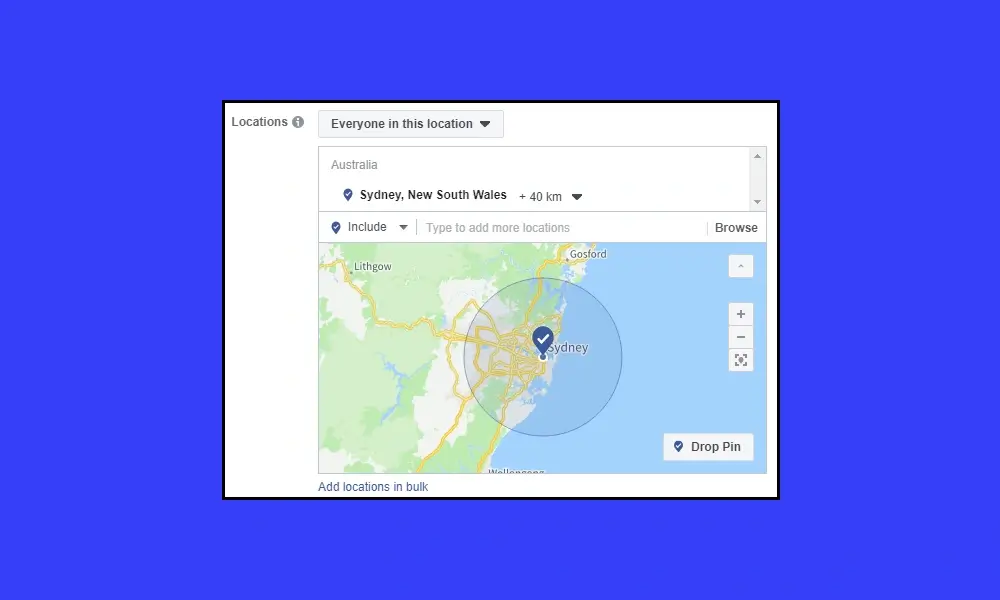
Image Source: GCG Media
Location targeting is one of the most powerful tools in your Facebook advertising arsenal. Local businesses with a ₹500/day budget can see their conversion rates jump up to 500% by defining their geographical reach precisely [link_1].
How to use Facebook Ads location targeting
Facebook lets you display ads based on where people live or have recently visited. The platform provides several location targeting options:
- Countries, regions, and cities
- Postal codes and addresses
- In the US: DMAs, Comscore Markets, and congressional districts
You can implement location targeting by following these steps:
- Go to Ads Manager while creating your campaign
- Look for the “Locations” field under the audience section
- Choose your main targeting method (people living in, recently in, or traveling to locations)
- Add specific locations that matter to your business
Facebook determines user location through various signals, though not always with perfect accuracy. Your ads might sometimes appear outside your targeted zones.
Setting radius around your business
Radius targeting gives brick-and-mortar businesses precise control over their local reach. You can choose between two main options:
Automatic radius: The platform adjusts the radius based on population density to ensure you reach enough people.
Fixed radius: You define an exact distance (in miles or kilometers) around your location.
Business owners with multiple locations should create store sets:
- Pick “Awareness” as your objective in Ads Manager
- Enable the “Store locations” toggle
- Click “Create a new store set”
- List your addresses and define your preferred radius for each location
This method eliminates targeting overlap between different business locations and makes your budget more effective.
Avoiding common mistakes in local targeting
Your ₹500 daily budget can quickly disappear due to these common targeting mistakes:
- Outdated location settings: Old targeting parameters waste your budget by reaching wrong regions with clicks that never convert.
- Overly restrictive radius: A radius that’s too small might leave out potential customers who live nearby.
- Excessive radius coverage: Many new marketers target unnecessarily large areas instead of focusing on specific regions that could generate more interest.
- Location targeting overlap: Multiple location circles can intersect and show your ads repeatedly to the same people, which confuses consumers.
Success comes from regular performance reviews of your location targeting. Your budget should shift toward better-performing areas if certain locations don’t deliver results.
Building the Right Audience Segments
Your ₹500 daily budget works best when you target the right people through precise audience segments. Local businesses can connect with potential customers by using Facebook’s powerful segmentation tools that match specific characteristics and behaviors.
Creating custom audiences from existing data
Your first-party data helps you reconnect with people who know your business through custom audiences. The process starts when you upload your customer list to Facebook Ads Manager. The system matches this information with Facebook users. Your customer files should include emails, phone numbers, and other contact details from existing customers, leads, and newsletter subscribers.
These audiences deliver great results because they target people already interested in your business. Research shows that segmented, targeted, and triggered campaigns generate 77% of ROI. Facebook Custom Audiences help you reach contacts through ads even when email open rates stay around 16.75%.
Using lookalike audiences for local reach
New customers who share traits with your existing ones can be found through lookalike audiences. Facebook looks at demographics, interests, and behaviors from your source audience to find similar users.
The best results come from a source audience of 1,000-5,000 people. You’ll need to pick a percentage range that shows how closely the new audience matches your source. Local businesses often see better performance with smaller percentages (1%) as these match more closely.
Layered targeting: combining interests, behaviors, and demographics
Your audience segments become highly specific when you combine multiple targeting options:
- Demographics: Your ideal customers’ age, gender, and location
- Interests: Hobbies and priorities that line up with what you offer
- Behaviors: Recent purchases and online activities
Facebook ads work best with an audience size between 2-10 million people. Adding interest targeting helps local businesses with smaller reach target ads to responsive users. Facebook suggests keeping at least 2 million people in your audience.
Excluding irrelevant users to save budget
Smart exclusions make your campaigns perform better. You can cut cost per click by 32% and boost conversion rates by 48%. Think about excluding:
- Past purchasers (for first-time offers)
- Your own employees
- Areas you don’t serve
- Age groups that don’t convert
- Users who bounce quickly
These audience segmentation techniques help your ₹500 daily budget deliver the best results for your local business when used together.
Optimizing Ad Formats and Creative for Local Impact
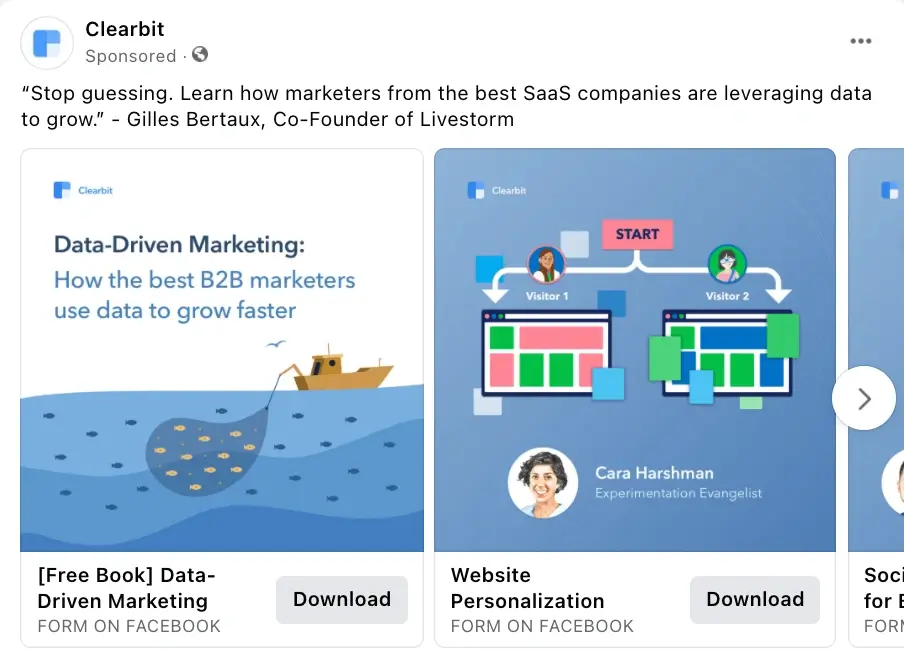
Image Source: KlientBoost
Your local business’s Facebook campaign performance can improve dramatically when you pick the right ad format. A ₹500 daily budget will work harder and bring more people to your store when you optimize your creative elements properly.
Best ad formats for local businesses
Local awareness ads work great at promoting businesses to people nearby, which makes them perfect for boosting visibility and foot traffic. Image ads stand out because they’re simple—a professional photo of your storefront or team creates a strong first impression. Video ads grab attention exceptionally well; as one expert noted, “If a picture is worth a thousand words, then a video is worth a book”. Carousel ads help you showcase multiple products or menu items in a single swipeable ad. Service businesses benefit from lead form ads that collect contact information directly within Facebook, which reduces friction.
Using map cards and call-to-action buttons
Store traffic ads come with a powerful “Get Directions” CTA button that opens users’ map applications. Your business address automatically loads up, giving potential customers an uninterrupted experience. It’s worth mentioning that 98.5% of Facebook users access via mobile devices, which makes mobile optimization vital. Your CTA should appear in the first 90 characters of your ad copy to maximize visibility. Along with “Get Directions,” buttons like “Learn More,” “Call Now,” and “Book Now” work well.
Highlighting local offers and testimonials
Local customers respond well to special promotions and limited-time offers. Seasonal offers create urgency, especially during slower business periods. Customer reviews added to Facebook ads help build trust and credibility. These reviews are a great way to get social proof, which shows potential customers other people’s positive experiences with your business. You can ask your servers or staff to keep track of customers who mention seeing your Facebook ad.
A/B testing creatives for better engagement
A/B testing helps you compare two ad versions by changing variables like images, text, audiences, or placements. Here’s how to run effective tests:
- Choose a clear hypothesis first
- Use similar budgets for both versions
- Avoid informal testing (manually turning ads on/off)
- Test one element at a time
This method will give a statistically comparable split between audiences. Testing different CTAs brings significant value—an AdEspresso study found “Download” performed better than “Learn More” with higher click-through rates.
Conclusion
Facebook Ads targeting is a chance for local businesses to get the most from their marketing budget. A ₹500 daily investment can bring amazing results if you know how to use the platform’s targeting features.
Local businesses have different challenges than national advertisers. Facebook’s location targeting tools are perfect for neighborhood-focused campaigns. Your campaign’s success depends on picking the right objectives and budget allocation. You also need to become skilled at location targeting with proper radius settings.
Creating specific audience segments makes all the difference between wasted spending and profitable campaigns. Custom audiences from your customer data paired with lookalike audiences help you reach more relevant people. On top of that, layered targeting with demographics, interests, and behaviors helps find people who need your products.
Ad format choice is crucial as your audience selection. Map cards with direction buttons, local testimonials, and community-specific offers give potential customers compelling reasons to visit. Dewbytes can help with Facebook Ad services to generate leads and create winning campaigns for your brand. Their expertise can raise your Facebook advertising strategy with professional guidance.
Note that Facebook advertising needs patience and regular testing. Begin with our suggestions, monitor your results, and make evidence-based changes to improve over time. These targeting strategies help your local business compete with larger companies while you retain control of your ad budget.
Facebook’s precise targeting features let small businesses connect with the right local customers. Put these strategies to work today and watch your ₹500 daily investment turn into a steady stream of new customers at your door.
Key Takeaways
Master Facebook’s targeting tools to transform your ₹500 daily ad budget into a powerful customer acquisition engine for your local business.
• Start with location-first targeting: Set precise radius targeting around your business location and use store traffic ads with “Get Directions” buttons to drive foot traffic effectively.
• Build smart audience segments: Create custom audiences from existing customer data, then use 1% lookalike audiences to find similar local prospects while excluding irrelevant users.
• Choose lead generation objectives: Focus on the “Leads” campaign objective rather than just sales, as it’s specifically designed to collect contact information from local prospects.
• Test local-focused creatives: Use customer testimonials, seasonal offers, and mobile-optimized ad formats since 98.5% of Facebook users access via mobile devices.
• Allow algorithm learning time: Give Facebook at least one week and 50 optimization events before making major changes to avoid disrupting the learning phase.
When executed properly, these targeting strategies enable local businesses to compete effectively against larger competitors while maintaining complete control over their advertising investment and generating consistent customer acquisition results.
FAQs
Q1. How can local businesses effectively target their audience on Facebook?
Use Facebook’s location targeting tools in Ads Manager to reach people within a specific radius of your business. You can target based on city, zip code, or address, and even create store sets for multiple locations to avoid overlap.
Q2. Are Facebook ads worthwhile for small local businesses?
Yes, Facebook ads can be highly effective for local businesses. They offer precise targeting options that allow you to reach a focused local audience, often at a lower cost than traditional advertising methods.
Q3. What’s the best way to optimize Facebook ad creatives for local impact?
Use ad formats like local awareness ads with map cards and “Get Directions” buttons. Incorporate customer testimonials and highlight special local offers. Ensure your ads are mobile-optimized, as most Facebook users access the platform via mobile devices.
Q4. How should local businesses structure their Facebook ad campaigns?
Start with the “Leads” campaign objective to collect contact information from local prospects. Set a daily budget (around ₹500-₹1000) for consistent exposure. Use custom audiences from your existing customer data and create lookalike audiences to find similar local prospects.
Q5. How long should local businesses run Facebook ads before making changes?
Allow Facebook’s algorithm at least one week and 50 optimization events (such as clicks or leads) before making significant changes to your campaign. This learning phase helps the system optimize ad delivery for better performance over time.
Author
-
SEO (AEO, GEO & LLM) & Ads Expert | WordPress Dev.
With over 10 years of hands-on experience, I help businesses grow online through impactful SEO (AEO, GEO & LLM) strategies, high-converting ad campaigns and fast, user-friendly WordPress websites. My expertise spans on-page, off-page and technical SEO, as well as Google and Meta (Facebook/Instagram) Ads. I also specialize in custom website development—whether built from code or using WordPress My work focuses on helping businesses grow online through smart SEO strategies, high-converting Google & Meta (Facebook/Instagram) ad campaigns and fast, user-friendly WordPress websites.
I have in-depth expertise in on-page, off-page and technical SEO, along with custom website development using code or WordPress. I offer a full-stack digital marketing solution designed to drive targeted traffic, boost conversions, and deliver real results. Through this blog, I share practical insights, proven tactics and the latest trends to help brands succeed online as of my Experiences.
